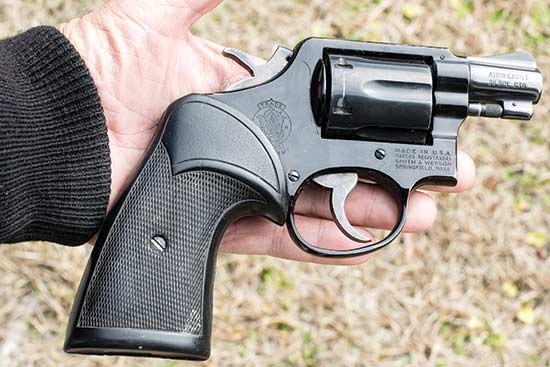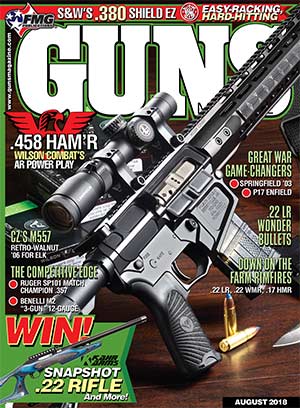The Case For Big Butts
On January 22, 2018, GLOCK released its newest pistol to the public — the 19X. It’s essentially the company’s entry into the recent competition for the new US military sidearm, minus the Government-requested thumb safety. This 9mm semi-auto features the barrel/slide assembly of the popular G19 compact with the full-length grip-frame and 17-round magazine of the service-size G17.
Unlike most pistols from this maker, the 19X promoted howls from the GLOCK fanboys. “What were they thinking?” they cried on the Internet. “They’ve got it backwards! We want the compact bottom so the short butt won’t print in concealed carry, with the longer top end for better sight radius and a little more power!”
The way I see it, the critics only got it half right. Shortening the butt of a G19 to the length of a subcompact G26, but keeping the G19-size barrel and slide is certainly a popular gunsmith modification for the reasons described above. And it has become a popular format in other pistol platforms, most notably the stubby 1911 Officers frame under the 4.25″ Commander-length barrel and slide, introduced in the 1990s by Colt with their CCO and duplicated today by other 1911 companies, the Nighthawk T3 being one example.
What the critics are missing, though, is the rationale of doing it vice-versa, small top over large bottom. (Yes, I know what this sounds like, but please, no Hillary Clinton jokes.)
Legitimate Rationale
OK, a longer barrel does give you a longer sight radius, which is conducive to improved accuracy. However, the longer sight radius also takes slightly longer to align at high speed.
Some shooters find the shorter slides “track faster.” Meaning they get back on target faster after the recoil and feeding cycle. Matchmeister Mike Ross has won many GLOCK shoots (www.gssfonline.com) and in the stock gun events prefers the shorter G19 over the longer G17. He told me it’s because the shorter gun simply gets back on target faster.
So, where does the larger butt come in? Speed of access and presentation for one thing. Most shooters find the larger grip easier for the hand to find, particularly when that hand has to claw under a concealing garment to take purchase.
Let me explain further. “Appendix carry” is increasingly popular today. With the gun barrel at or near centerline, the grip frame is held tight against the wearer’s abdomen (near the appendix for a right-handed shooter). The operative term there is “held tight against.”
First, the good news: it offers great concealment. The bad news? A flat-sided auto’s grip pressed against the belly requires the fingertips of your drawing hand to dig between gun and flesh to make the initial grasp. Many appendix carriers have found the longer the grip, the easier and faster it is to get a secure grasp to begin the draw. The extra length of butt becomes less relevant in the appendix position because there’s more of your body to snuggle up against between navel and edge of hip than there is on most people from front to back. This makes concealment of the large-butt gun easier in appendix carry than hip carry.
Balance Of Attributes
Short barrel/big butt combinations have been with us for a long time and have never been astoundingly popular. In modern striker-fired duty pistols, the FN 509 had the 4″ barrel/long grip-frame/17-round magazine of the 19X well before the 19X was introduced.
Before either of them, Springfield Armory’s first short barrel version of their XD(m) had a full-length butt with a 19-round magazine. Each of these pistols found favor with some folks, but none have become best-sellers.
One reason why is in a hip holster, a short barrel gun does not bear as much on the hip — tucking the gun butt into the body — as a longer barreled gun can in a proper scabbard.
In his classic (circa 1960) Handgunner’s Guide, the master of quick draw and holster-making, Chic Gaylord, had this to say: “The three hardest guns to holster with any degree of comfort and concealment — what I call the “top-heavy trio” — are the 2″ Colt Marshal, Smith & Wesson’s 2″ Military and Police revolver, and Smith & Wesson’s .357 Magnum with the 3.5″ barrel. These guns have large grips, heavy cylinders and frames, and nowhere near enough barrel to balance them in the holster. Why anyone would carry around so much excess weight in a weapon having such ineffective ballistics is beyond me. Two more inches added to the barrel would increase the total weight of the gun by not over four ounces, resulting in an effective weapon that could be carried with far greater comfort and concealment.”
I would not place a bet with a bookie the G19X will outsell the other G19s. Still, I do think the “big butt/short barrel” concept has a place and will be found ideal by some people. And for valid reasons.







